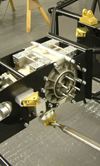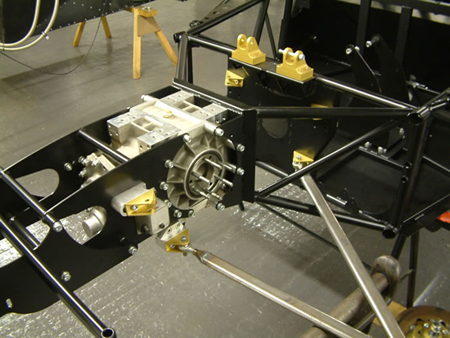Motorcycle-engined cars
 While most press coverage of motorsport tends to look at big-budget motor racing, there are interesting technical features on many of the lower-budget machines that pound around the circuits during the summer weekends. There are a number of race series where lightweight cars powered by motorcycle engines are popular and successful. In the UK, Radical in particular has made a very successful business out of building bike-engined sportscars, and its V8 car has an engine based on two motorcycle top ends.
While most press coverage of motorsport tends to look at big-budget motor racing, there are interesting technical features on many of the lower-budget machines that pound around the circuits during the summer weekends. There are a number of race series where lightweight cars powered by motorcycle engines are popular and successful. In the UK, Radical in particular has made a very successful business out of building bike-engined sportscars, and its V8 car has an engine based on two motorcycle top ends.
In Britain, besides sportscars such as the Radical, there are a number of manufacturers providing cars powered by bike engines to compete in circuit racing, sprinting and hillclimbing. Often the bike-engined cars can punch 'above their weight' and achieve good results in a straight fight with much more powerful opposition.
Bike engines are relatively cheap and very light. The low mass is important in these lightweight, nimble cars. Moreover, there's a good number of very powerful stock engines from 600 cc to 1400 cc, and conversion kits to take them to even greater capacity. The Suzuki Hayabusa engine is a popular choice for increased capacity, and a number of them in supercharged and turbocharged specs race in the UK.
There are two main problems, however, with using a bike engine for car use. First, it has no reverse gear, and in many cases the regulations require that the car is able to move in reverse under its own power. Second, there is no differential, so there is a ready market for limited-slip differentials with a reversing capability, and a number of manufacturers currently service this requirement.

I recently spoke to Elite Racing Transmissions from Stoke-on-Trent in England about its MX200 reversing differential, which is made specifically for bike-engined cars. The MX200 differential is designed for bike engines mounted longitudinally, such that the input shaft runs parallel to the direction of car travel, and this means it is suitable for front-engined and rear-engined cars alike.
The unit features a Salisbury-type limited-slip differential - a system based effectively on a friction clutch that limits the slip between the two output shafts as their speeds differ - and a particular design feature is the system of easy-access drop gears that allow "a rapid change of the overall final drive ratio" according to Elite's sales manager Richard Homer. For this particular system the range of final drive ratios can be varied between 2.67:1 and 8.75:1.
On that point, there is a useful resource on the Spire Owner's club website (www.spireoc.co.uk), which has a handy calculator for drive ratios for bike-engined cars. There are a number of companies manufacturing small, agile cars for hillclimbing and sprinting, such as ADR Engineering, which recommends and supplies this differential with a each complete car or kit.
This particular differential from Elite weighs in at 32kg, and is designed not only to cope with the extra power afforded by engines with increased capacity, but also with the often substantial increases in power and torque associated with turbo and supercharged applications, with Homer saying it is "designed for turbo Hayabusa power".
Fig. 1 - This limited-slip differential is especially designed for bike-engined applications, incorporating a reverse gear (Courtesy of Elite Racing Transmissions)
Written by Wayne Ward